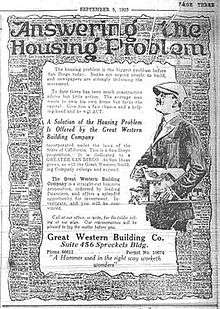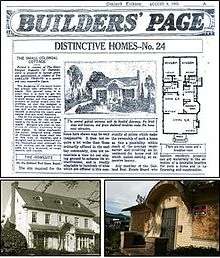Better Homes in America

In 1922 the United States embraced a nationwide campaign of home ownership, modernization, and beautification because of a critical shortage of homes in the years right after World War I. This was the Better Homes Movement, which was initiated in the pages of the Butterick Publishing Company's household magazine, The Delineator,[1] under the editorship of Marie Mattingly Meloney. The campaign celebrated home ownership, home maintenance and improvement, and home decoration as means of motivating responsible consumer behavior; it also expanded the market for consumer products. Annual local campaigns — or "better homes demonstration weeks" — encouraged people to own, build, remodel, and improve their homes and distributed advice on creating home furnishings and decorations.
President Warren G. Harding and Secretary of Commerce Herbert Hoover kicked off the first Better Homes Week in October 1922 for the National Better Homes Advisory Council. The campaign centered on the 100th anniversary of John Howard Payne’s song Home! Sweet Home!. The Better Homes Movement received broad support from both government and industry. Vice-President Calvin Coolidge served as honorary chairman of the Advisory Council of Better Homes in America, and Secretary of Commerce Herbert Hoover was president of its board of directors.
To commemorate the Better Homes Movement, a replica of Payne’s colonial home in Long Island, New York, was built on the White House lawn in Washington, D.C. More than a million people visited the Payne House, and newspapers across America promoted other small Colonial Revival cottages like it.[2]
Because of the patriotic and national sentiment of these years so soon after World War I, many of the model homes exhibited various Colonial Revival architectural elements. Newspapers often published designs of modest homes that were affordable and attractive to encourage new home construction under the Better Homes program.

The Guidebook for Better Homes Campaigns in Rural Communities and Small Towns[3] shows how the campaign sought to communicate its ideas. School Cottages for Training in Home-making[4] shows how high school courses incorporated the ideas of the campaign. The movement sought to educate consumers, but it also served the interests of powerful groups and organizations: The connection between the campaign's educational and commercial concerns is illustrated by Hoover's essay "The Home as an Investment" in the Better Homes in America Plan Book for Demonstration Week, October 9 to 14, 1922.[5] See also: "Homemaker-Consumer Life in Washington, D.C., 1922-23"[6] from the Anna Kelton Wiley Papers.
References
- ↑ The Library of Congress American Memory Website: http://memory.loc.gov/cgi-bin/query/r?ammem/coolbib:@field(NUMBER+@band(amrlgs+dl1))
- ↑ 1923 Roy and Dora Bennett Home in San Diego
- ↑ The Library of Congress American Memory Website: http://memory.loc.gov/cgi-bin/query/r?ammem/coolbib:@field(NUMBER+@band(amrlg+lg58))
- ↑ The Library of Congress American Memory Website: http://memory.loc.gov/cgi-bin/query/r?ammem/coolbib:@field(NUMBER+@band(amrlg+lg55))
- ↑ The Library of Congress American Memory Website: http://memory.loc.gov/cgi-bin/query/r?ammem/coolbib:@field(NUMBER+@band(amrlg+lg03))
- ↑ The Library of Congress American Memory Website: http://memory.loc.gov/cgi-bin/query/r?ammem/coolbib:@field(NUMBER+@band(amrlm+mk03))